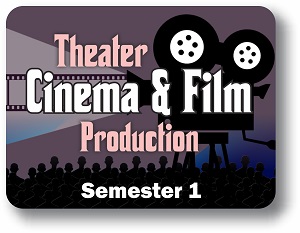Theater Cinema and Film Production Semester 1

Course Overview:
Lights! Camera! Action! This course will introduce students to the basics of film and theater productions. Students will learn about the basics of lighting, sound, wardrobe, and camerawork for both film andtheater settings. The course also explores the history of film and theater and the influence that they have had on society. Students will analyze and critique three influential American films. In this semester, you will learn film history and film theory, what theater is, what its purposes can be, and a bit of theater’s history, lighting, how lenses and filters are used to create the types of shots that directors seek, how the camera’s position and movement can be manipulated to make a movie more engaging and aesthetically enjoyable, sound in both film and theater, and wardrobe and makeup in both film and theater.
Required Materials:
You will be required to own or have access to the standard editions of the three films used in this
course:
- Singin’ in the Rain (1952)
- Wizard of Oz (1939)
If you do not already have access to these movies, you may consider other sources such as your local
library.
Note: Timestamps referenced throughout the course apply to standard editions of the applicable film and may not align with any extended/modified versions.
Syllabus:
Unit 1: Introduction to Film Theory
In this unit, you will learn several things about film history and film theory: what a film is, what a film’s purpose may be, and why that purpose is important when learning about and using film theory. You’ll be introduced to one particular type of film theory. And you’ll look at your own experiences with films as well as the experiences scholars, critics, and historians have had as you begin your journey into the world of film theory.
What will you learn in this unit?
- Identify what type(s) of films are used in film theory.
- Explain the differences and similarities between film criticism and film theory.
- Learn about different purposes for the creation of films.
- Name one example film for each film purpose.
- Explain auteur theory.
Unit 2: The World of Theater
Before motion pictures were invented, theater provided entertainment for cultures around the world. Theater has provided structure and inspiration for modern films, and the interplay between film and theater helps us better understand the creation and impact of films. In this unit on theater, you will learn several things: what theater is, what its purposes can be, and a bit of theater’s history. You’ll learn what’s necessary for theater to exist. And you’ll draw on your experiences with performance and theater to make connections with what you learn in this unit as well as with what you learned in the previous unit on film theory.
What will you learn in this unit?
- List and explain theater’s main requirements.
- List and explain some of theater’s main purposes.
- Explain the roles of religion, myth, and philosophy in the development of theater.
- Discuss Aristotle’s view of catharsis.
- Describe why theater is a form of art.
Unit 3: Lighting the Scene
In this unit on theater and film, you’ll learn about one of the important technical aspects of creating a world on both film and stage—lighting. You’ll learn the purposes of lighting for both film and theater. You’ll discover the different ways that light can be manipulated for these different purposes.
What will you learn in this unit?
- Identify and describe the two main purposes of lighting in film and theater.
- Identify and describe the three specific elements of lighting that can be changed.
- Identify and describe various tools and tricks used to manipulate lighting in both film and theater.
Unit 4: The Basic Elements of Camerawork
In this unit, you will learn about camera technology and equipment that is used when making a film. You’ll learn how lenses and filters are used to create the types of shots that directors seek. And you’ll learn how the camera’s position and movement can be manipulated to make a movie more engaging and aesthetically enjoyable.
What will you learn in this unit?
- Identify and describe the two camera types used in making films.
- Discuss the purpose of camera equipment.
- Describe the types of lenses and filters as well as the types of shots they produce.
- Discuss how a camera can be moved and positioned to create different types of shots.
Unit 5: Managing Sound in Film and Theater
In this unit, you will learn about sound in both film and theater. You’ll learn how sound is created and recorded for films as well as how it is created and managed in theatrical productions. And you’ll learn about some of the equipment that sound professionals use in their jobs.
What will you learn in this unit?
- Compare and contrast the use of sound in film and theater productions.
- Describe the sound equipment used for film and theater productions.
- Name the people involved with sound in film and theater productions and describe their responsibilities.
Unit 6: Wardrobe
In this unit, you will learn about wardrobe and makeup in both film and theater. You’ll learn how characters’ appearances are designed and brought to life and about the professionals who do this. And you’ll learn about the unique concerns that must be taken into consideration during the wardrobe and makeup processes.
What will you learn in this unit?
- Describe the processes of wardrobe and makeup design and creation.
- Compare and contrast wardrobe and makeup in stage performances and on film screens.
- Name the people involved with wardrobe and makeup in film and theater productions and describe their responsibilities.


